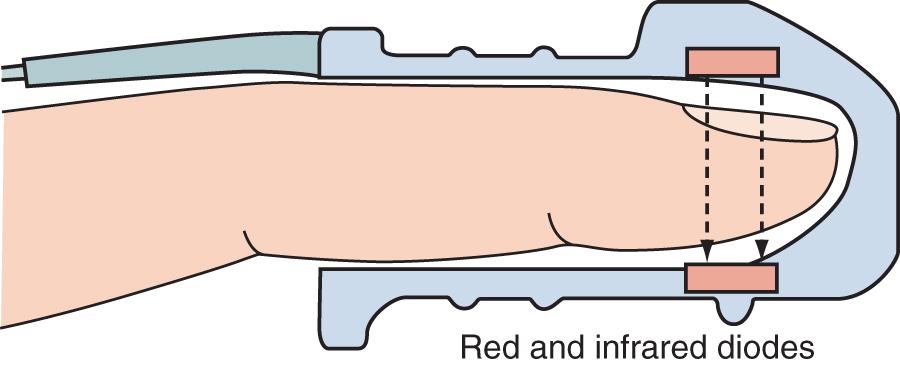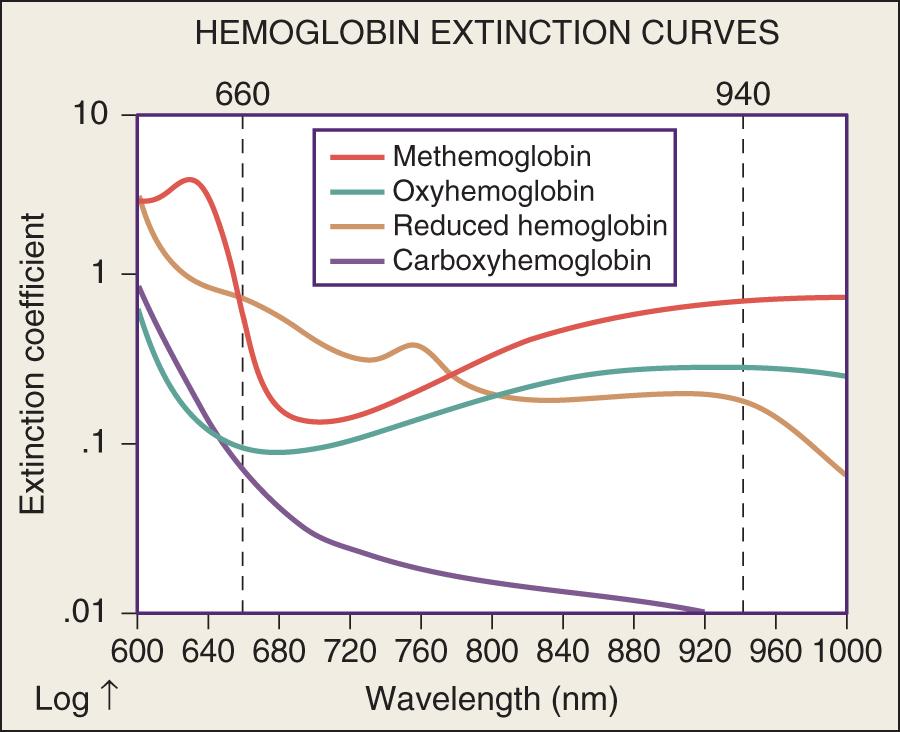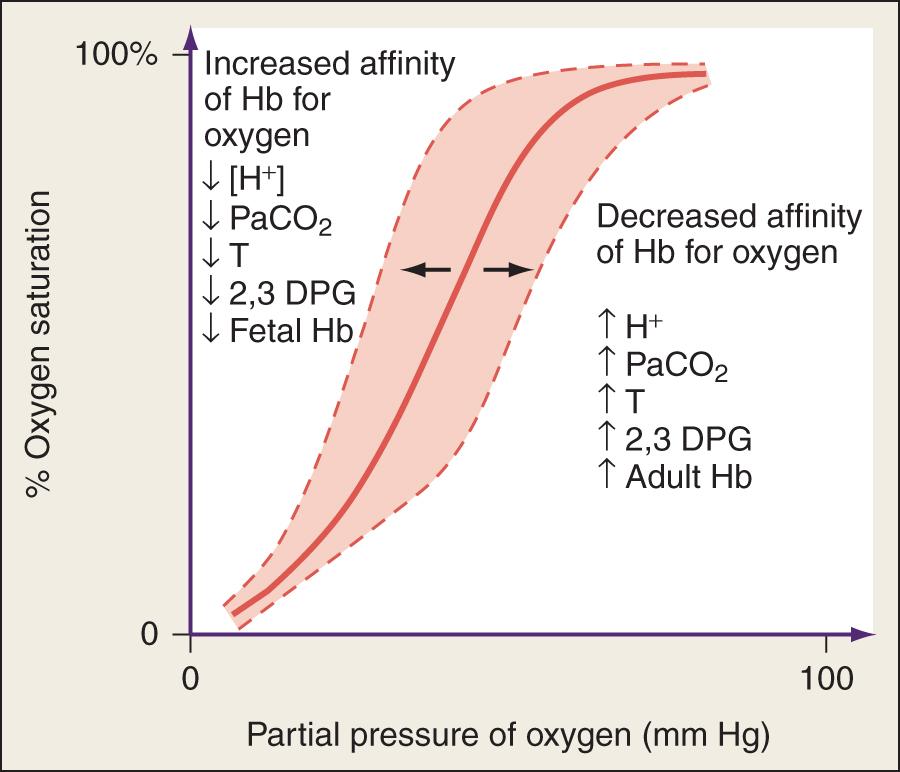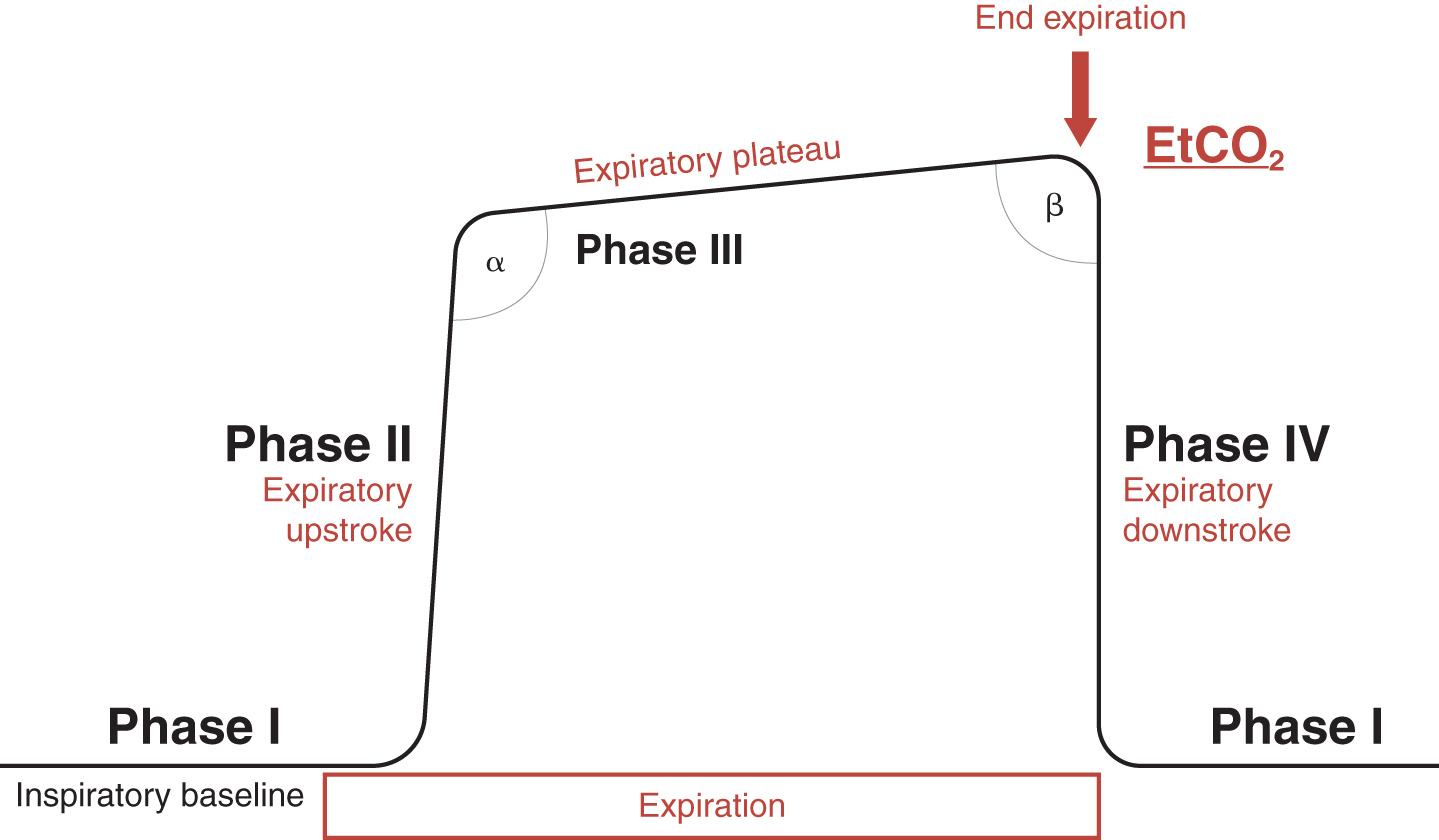Physical Address
304 North Cardinal St.
Dorchester Center, MA 02124
Pulse oximetry is a microprocessor-based measurement that incorporates both oximetry and plethysmography to provide continuous noninvasive monitoring of the oxygen saturation of arterial blood (SpO 2 ). Often considered the “fifth vital sign,” pulse oximetry is one of the most important technologic advances for monitoring patients during anesthesia, in the intensive care unit (ICU), on the general ward, in the emergency department, and during a wide variety of procedures. It can quickly detect even small changes in the effectiveness of oxygen uptake from the lung and how efficiently oxygen is carried to the tissues. Common applications for pulse oximetry may include mechanical ventilation, surgical monitoring, sleep evaluations, and effectiveness of certain clinical interventions.
The most common pulse oximeter probe is embedded into either a reusable clip probe or a single-patient adhesive probe and consists of two light-emitting diodes on one side and a light-detecting photodiode on the opposite side. Advantages of the reusable clip probe include utilization rapidity, ease of sampling different sites, and cost-effectiveness. Advantages of the single-patient adhesive probe include less potential for infection transmission, more secure placement, and the ability to monitor at more body sites. The most appropriate type of probe depends on the clinical situation. Either a finger, toe, or earlobe serves as the sample “cuvette” because the skin in these areas has a high vascular density. Pulse oximetry targets the signal arising from the arterial bed as light absorbance fluctuates with changing blood volume. Arterial blood flow causes signal changes in light absorption (the pulsatile component called photoplethysmography ) that can be distinguished from venous and capillary blood in the surrounding tissues (the baseline, or direct current, component; Fig. 33.1 ).

According to the Beer-Lambert law, the concentration of a substance can be determined by its ability to transmit light. Oxygenated hemoglobin (HbO 2 ) and deoxygenated or “reduced” hemoglobin (HbR) species absorb light differently, so the ratio of their absorbencies can be used to calculate HbO 2 saturation. The standard pulse oximeter emits two wavelengths of red light (660 nm and 940 nm) from the light-emitting diode on one side of the probe, through the capillary bed, to a light-detecting photodiode on the other side. Red light emitted at 940 nm is mainly absorbed by HbO 2 , whereas red emitted at 660 nm is mainly absorbed by HbR. The difference between the transmitted light and unabsorbed light represents the amount of hemoglobin-bound oxygen and is expressed as a percentage.
In addition, there are two minor hemoglobin (Hb) species: carboxyhemoglobin (COHb) and methemoglobin (MetHb). Fractional SaO 2 is the proportion of HbO 2 relative to all four hemoglobin species:
Measuring fractional hemoglobin requires a co-oximeter that incorporates four wavelengths to distinguish each species ( Fig. 33.2 ). In contrast, oxygen saturation as determined by pulse oximeter (SpO 2 ) uses two wavelengths, so that it measures functional SaO 2 :

The accuracy of pulse oximeters has improved over the years. In critically ill patients with an arterial oxygen saturation (Sa O 2 ) >90%, it is now estimated that the mean difference between SpO 2 and SaO 2 is less than 2%. , Also, the standard deviation of the differences between the measurements represents the precision and has been estimated to be less than 3%. , However, when the SaO 2 drops below 90%, the accuracy of SpO 2 measurements decreases.
The oxyhemoglobin dissociation curve must be taken into account when interpreting the SpO 2 ( Fig. 33.3 ). If the curve is in a normal position, then high SpO 2 values (96%–98%) represent a PaO 2 in the range of 80–100 mm Hg, whereas SpO 2 values in the low to mid 90s represent a PaO 2 in the range of 60–80 mm Hg. An SpO 2 <90% indicates PaO 2 values that enter into the hypoxemic range. If the curve shifts to the left, a lower PaO 2 will produce a higher SpO 2 , whereas the reverse is true if the curve is shifted to the right. Although a left shift in the oxyhemoglobin dissociation curve increases the affinity of Hgb for oxygen, it also makes it more difficult for the Hgb to release oxygen molecules. A right shift in the curve makes it more difficult for the Hgb to load oxygen molecules (see Fig. 33.3 ).

Because pulse oximeters detect very small optical signals (and reject a variety of artifacts), data must be averaged over several seconds, thus affecting the response time. , A prolonged lag time is more common with finger probes than with ear probes and is attributed to hypoxia-related peripheral vasoconstriction. Bradycardia is also associated with a prolonged response time.
Despite recent technologic advances, there still are a number of factors that may affect the accuracy of the pulse oximeter. Table 33.1 lists the most common ones.
| Factor | Effect |
|---|---|
| Carboxyhemoglobin (COHb) | Slight reduction in accuracy of the assessment of oxygen saturation (SaO 2 ) by pulse oximetry (SpO 2 ) (i.e., overestimates the fraction of hemoglobin available for O 2 transport) |
| Methemoglobin (MetHb) | At high levels of MetHb, SpO 2 approaches 85%, independent of actual SaO 2 |
| Methylene blue | Transient, marked decrease in SpO 2 lasting up to several minutes; possible secondary effects as a result of effects on hemodynamics |
| Anemia | If SaO 2 is normal, no effect; during hypoxemia with Hb values less than 14.5 g/dL, progressive underestimation of actual SaO 2 |
| Ambient light interference | Bright light, particularly if flicker frequency is close to a harmonic of the light-emitting diode switching frequency, can falsely elevate the SpO 2 reading |
| Blood flow | Reduced amplitude of pulsations can hinder obtaining a reading or cause a falsely low reading |
| Motion | Movement, especially shivering, may depress the SpO 2 reading |
| Nail polish | Slight decrease in SpO 2 reading, with greatest effect using blue nail polish, or no change |
| Sensor contact | “Optical shunting” of light from source to detector directly or by reflection from skin results in falsely low SpO 2 reading |
| Skin pigmentation | Small errors or no significant effect reported; deep pigmentation can result in reduced signal |
| Tape | Transparent tape between sensor and skin has little effect; falsely low SpO 2 has been reported when smeared adhesive is in the optical path |
| Vasodilation | Slight decrease in SpO 2 |
| Venous pulsation | Artifactual decrease in SpO 2 |
Motion artifact and poor perfusion are the most common sources of SpO 2 inaccuracies, which occur because the photoplethysmographic pulse signal is very low in these settings compared with the total absorption signal. , The combination of motion artifact and poor perfusion substantially lowers SpO 2 accuracy compared with either artifact alone. Causes of motion artifact include shivering, twitching, agitation, intraaortic balloon pump assistance, and patient transport. , Signs of motion artifact include a false or erratic pulse rate reading or an abnormal plethysmographic waveform. Peripheral hypoperfusion from hypothermia, low cardiac output, or vasoconstrictive drugs may increase bias, reduce precision, and prolong the time to detect a hypoxic event.
Newer technologies have helped reduce the incidence of these problems, but have not eliminated them as sources of error. Relocation of the probe may be required to obtain a more accurate signal.
Significant amounts of COHb or MetHb can cause errors in SpO 2 measurements. COHb and HbO 2 absorb equivalent amounts of red light. Because the amount of COHb is elevated in the setting of carbon monoxide poisoning, this results in a falsely elevated SpO 2 value because the pulse oximeter reports on total Hb saturation and not just HbO 2 saturation. The patient, however, could be experiencing profound hypoxemia. In contrast, MetHb causes substantial absorption of both red and infrared light, so the ratio approaches 1 (estimated SpO 2 of 85%). Significant levels of MetHb falsely lower SpO 2 values even when the actual SaO 2 exceeds 85% and falsely elevates values when the true SaO 2 is less than 85%. Additionally, the administration of methylene blue or indocyanine green dyes for diagnostic tests causes a false, transient (1- to 2-minute) drop in SpO 2 to as low as 65%. ,
There are some newer pulse oximeters that claim to measure actual hemoglobin concentration, but validation study results have yielded mixed results. ,
Both dark skin pigmentation and dark nail polish interfere with absorption of the wavelengths used by pulse oximetry. Pulse oximeters thus have greater bias and less precision in dark-skinned patients. Whereas an SpO 2 of 92% is sufficient to predict adequate oxygenation in light-skinned patients, a saturation of at least 95% is required in dark-skinned patients. Also, dark nail polish colors can falsely lower SpO 2 values, whereas red polish tends not to affect pulse oximetry accuracy. However, with newer technology, the negative effects of nail polish have been lessened. A study conducted with modern equipment showed an effect of dark nail polish on pulse oximetry readings, but the error was not clinically relevant. When nail polish cannot be removed, mounting the oximeter probe sideways on the finger may yield a more accurate reading.
Although pulse oximeters compensate for the presence of ambient light, the sensor should be shielded from intense light sources with an opaque material. Falsely low SpO 2 readings occur when even minor gaps exist between the probe and skin, allowing light reflected off the skin’s surface to “shunt” directly to the photodiode. Xenon surgical lamps and fluorescent lighting can also cause falsely low SpO 2 values. Under conditions of moderate to severe anemia (e.g., Hb 8 g/dL ) and severe hypoxemia (SaO 2 54%), SpO 2 bias is markedly increased (by approximately −14%). Hyperbilirubinemia does not affect SpO 2 directly. However, carbon monoxide is a by-product of heme metabolism, and deeply icteric patients tend to have higher levels of COHb, so SpO 2 may be falsely elevated under those conditions.
Pulsus paradoxus refers to an exaggerated fall in a patient’s blood pressure during inspiration. A recent meta-analysis evaluated the relationship between pulsus paradoxus and pulse oximetry. The findings suggested that pulse oximetry plethysmograms can also be used as a noninvasive method for estimating pulsus paradoxus. The authors further suggested that earlier recognition and improved management of elevated pulsus paradoxus may be achievable through the use of a pulse oximeter.
Reflectance pulse oximetry was designed to counter signal-detection problems associated with finger probes during hypoperfusion. The reflectance sensor is designed for placement on the forehead just above the orbital area, where superficial blood flow is abundant and less susceptible to vasconstriction. Whereas traditional probes work by transilluminating a tissue bed and measuring the forward-scattered light on the opposite side of the finger, toe, or earlobe, reflectance probes are constructed with the light-emitting diodes and the photodetector located along the same surface. The photodetector measures the back-scattered light from the skin. In addition, tolerance to site of placement for reflectance pulse oximetry has allowed fetal monitoring during labor. Intraesophageal SpO 2 monitoring is currently under investigation. Anasarca, excessive head movement, and difficulty in securing the probe site are some of the common problems encountered with reflectance pulse oximetry. Light “shunting” from poor skin contact and direct sensor placement over a superficial artery are associated with artifacts. However, recent studies have shown reflectance pulse oximetry to be as effective as phalanx finger sensors in many situations.
Continuous pulse oximetry provides an early warning sign of evolving hypoxemia. A large single-center randomized controlled trial of perioperative patients found reported incidence rates of hypoxemia (SpO 2 less than 90%) to be 7.9% in patients monitored with pulse oximetry and only 0.4% in patients monitored without an oximeter. From a surgical perspective, a study reported that continuous monitoring of SpO 2 revealed episodic and severe hypoxemic events, with some desaturations lasting as long as 21 ± 15 minutes. Pulse oximetry has also been shown to aid in titrating FiO 2 in patients receiving mechanical ventilation. Two large clinical trials investigated whether or not the SpO 2 /FiO 2 (S/F) ratio could be a reliable proxy for the PaO 2 /FiO 2 (P/F) ratio in patients with acute lung injury (ALI) or acute respiratory distress syndrome (ARDS). The S/F ratio was reported to be a dependable surrogate in patients undergoing surgery, patients requiring increased levels of positive end-expiratory pressure (PEEP), and in calculating the sequential organ failure assessment scores.
Capnometry affords the measurement and numeric display of expired carbon dioxide (CO 2 ) at the patient’s airway opening. When a waveform plotting CO 2 against time or volume is also displayed, the process is referred to as capnography , and the waveform is referred to as a capnogram . Capnometry is most commonly used on patients receiving mechanical ventilation and uses infrared light projected through a gas sampling chamber to a detector on the opposite side. CO 2 absorbs infrared light at a peak wavelength of approximately 4.27 μm. , More infrared light passing through the sample chamber (i.e., less CO 2 ) causes a larger signal in the detector relative to the infrared light passing through a reference cell. The sample chamber is either connected directly to the Y-adapter of the ventilator circuit (mainstream) or by a sampling line at the Y-adapter that continuously aspirates gas into a sampling chamber located inside the monitor (sidestream). A colorimetric CO 2 detector is an example of a mainstream capnograph. This device has a pH-sensitive indicator that changes color in response to varying CO 2 concentrations during inspiration and expiration. A normal capnograph has a square-wave pattern with four different phases, which begins during the inspiratory phase and will continue through the entire expiratory phase ( Fig. 33.4 ). Phase I is the inspiratory baseline, which is caused by inspired gas with low levels of CO 2 . Phase II is the exhalation of mixed fresh and alveolar gas, resulting in a very rapid increase in CO 2 levels. Phase III is the alveolar plateau, where the last of the alveolar gas is sampled; this is commonly the end-tidal exhaled gas concentration (P etco 2 ). Phase IV reflects the reversal of gas flow direction (the expiratory downstroke) and the beginning of inspiration.

Become a Clinical Tree membership for Full access and enjoy Unlimited articles
If you are a member. Log in here